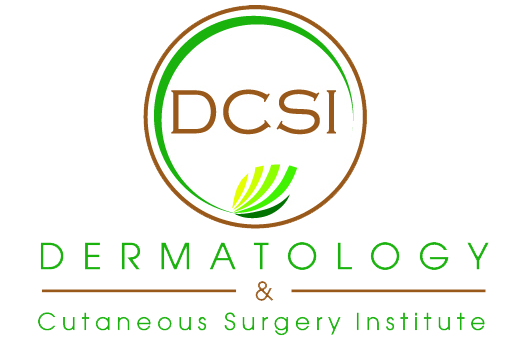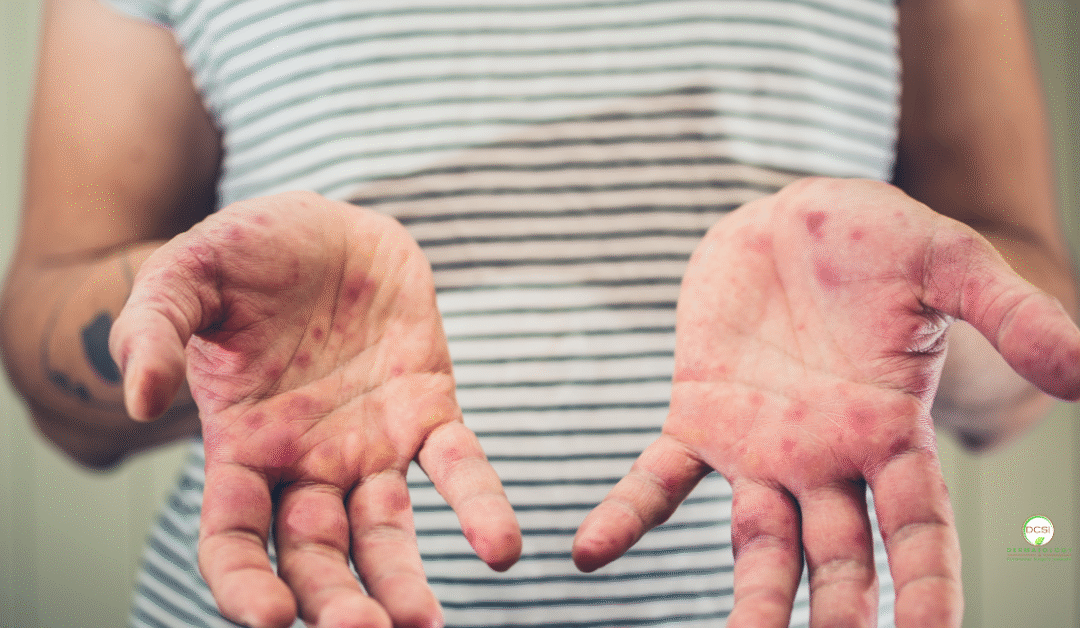As children return to daycare and classrooms, many families across Palm Beach County begin hearing about hand, foot, and mouth disease.1 This viral illness is most common in young kids and can spread quickly in group settings. Knowing the signs, how it spreads, and when to see a specialist helps you keep your child comfortable and prevent transmission.
At the Dermatology & Cutaneous Surgery Institute (DCSI), our board-certified dermatologists care for children and adults in Wellington and Delray Beach, serving nearby communities such as Palm Beach Gardens and West Palm Beach with convenient access and timely appointments.
What Is Hand, Foot, and Mouth Disease?
Hand, foot, and mouth disease is typically caused by enteroviruses, most often Coxsackievirus, and spreads through saliva, respiratory droplets, stool, and contaminated surfaces.[1,2] Daycares and schools are common places for exposure because of close contact and shared toys. While young children are affected most, teachers, caregivers, and parents can also become infected.[1] For a broader overview of pediatric skin issues, explore our pediatric skin conditions guide.
In most cases, hand, foot, and mouth disease is mild and short-lived, but an accurate diagnosis ensures you are treating the right condition and not missing red flags.[1,2]
Signs and Symptoms
Parents usually notice a small fever or sore throat, followed by painful mouth sores and an HFMD rash that appears on the hands, feet, and sometimes the buttocks.[1,2] These symptoms of hand, foot, and mouth can resemble other skin problems. For example, chickenpox may look similar early on; our clinical team explains the differences on the DCSI chickenpox resource page. If you are unsure what you are seeing, review our primer on different types of rashes and schedule a visit for confirmation.
Children with hand, foot, and mouth disease can be uncomfortable because mouth sores make eating and drinking difficult.1 Keeping up with fluids and pain relief is often the key to an easier recovery.
When to See a Dermatologist
Most families can manage symptoms at home, but you should contact a dermatologist if any of the following occur: the rash spreads or looks infected, your child has trouble drinking and risks dehydration, there is a persistent high fever, or the diagnosis remains unclear after initial care.[1]
If you need expert evaluation, our medical dermatology team offers same-week appointments in Wellington and Delray Beach. Many families searching for Palm Beach Gardens dermatologists or Delray Beach skin doctors choose DCSI because we combine pediatric experience with convenient access. Find directions and hours on our office locations page.
Treatment and Home Care
Because hand, foot, and mouth disease is viral, antibiotics do not help.1,2 Care focuses on comfort and preventing complications:
- Manage pain from mouth sores with clinician-recommended options.
- Encourage sips of cool fluids and soft foods to keep hydration up.
- Keep nails trimmed and hands clean to reduce scratching and secondary infection.
If you are already caring for a baby’s irritated skin, our practical diaper rash treatment guide outlines gentle routines that also promote healing during treatment for hand, foot, and mouth. Our clinicians will tailor advice to your child’s age, symptoms, and skin sensitivity.
Prevention and Family Tips
Viruses spread easily among kids who share toys and snacks. Good hygiene is the best defense: teach frequent handwashing, clean high-touch surfaces, avoid sharing cups and utensils, and keep children home while they have a fever or open blisters.1 South Florida’s warm, humid climate can sometimes accelerate outbreaks in schools and daycare settings. Families also ask about other contagious conditions, like molluscum, which passes from child to child through close contact; our overview of molluscum contagiosum treatment explains what to watch for and when to seek care.
Children with hand, foot, and mouth disease are most contagious during the first few days of illness, though viral shedding can continue for days to weeks.[1,2] Consistent hygiene helps limit the spread at home and during the return to class.
Local Care for Palm Beach County Families
Our dermatologists provide comprehensive care for children and adults at DCSI in Wellington and Delray Beach. Families who search for Wellington dermatology care often visit us for rapid assessment, clear guidance, and practical home care plans. We also routinely support parents from Palm Beach Gardens and West Palm Beach who want pediatric-savvy care close to home. If your child seems to have dermatology for rashes needs beyond routine advice, we are here to help with diagnosis, education, and follow-up.
Common Questions from Parents
Is HFMD contagious?
Yes. It spreads through saliva, respiratory droplets, stool, and contact with fluid from blisters.[1] Avoid sharing personal items, practice careful hand hygiene, and disinfect toys and surfaces regularly.
How long does it last?
Most children recover within 7 to 10 days with supportive care.[1,2] Call us sooner if your child cannot keep up with fluids, seems unusually lethargic, or if the rash looks infected.
Does HFMD leave scars?
Scarring is uncommon. Some children develop temporary marks or pigment changes after blistering, especially if there was scratching or infection.2 If you notice lingering spots, schedule a visit; we can review options for gentle skin recovery and answer questions about cosmetic concerns.
We provide pediatric-focused care throughout the county, including pediatric dermatology that Palm Beach families rely on for accurate diagnosis and practical guidance. If you are not sure whether your child’s rash is HFMD or another condition, our dermatologists can evaluate and recommend the next steps.
Next Steps for Palm Beach County Families
With the right plan, families can navigate hand, foot, and mouth disease with confidence. If you need an appointment, contact Dr. Mounir M. Wassef and the DCSI team in Wellington or Delray Beach for a prompt evaluation. You can also stay informed by reading the latest updates on our news and press page.
Sources
- Centers for Disease Control and Prevention. Hand, Foot, and Mouth Disease (HFMD). Accessed September 2025. https://www.cdc.gov/hand-foot-mouth/about/index.html
- StatPearls. Hand, Foot, and Mouth Disease. NCBI Bookshelf. Accessed September 2025. https://www.ncbi.nlm.nih.gov/books/NBK431082/


